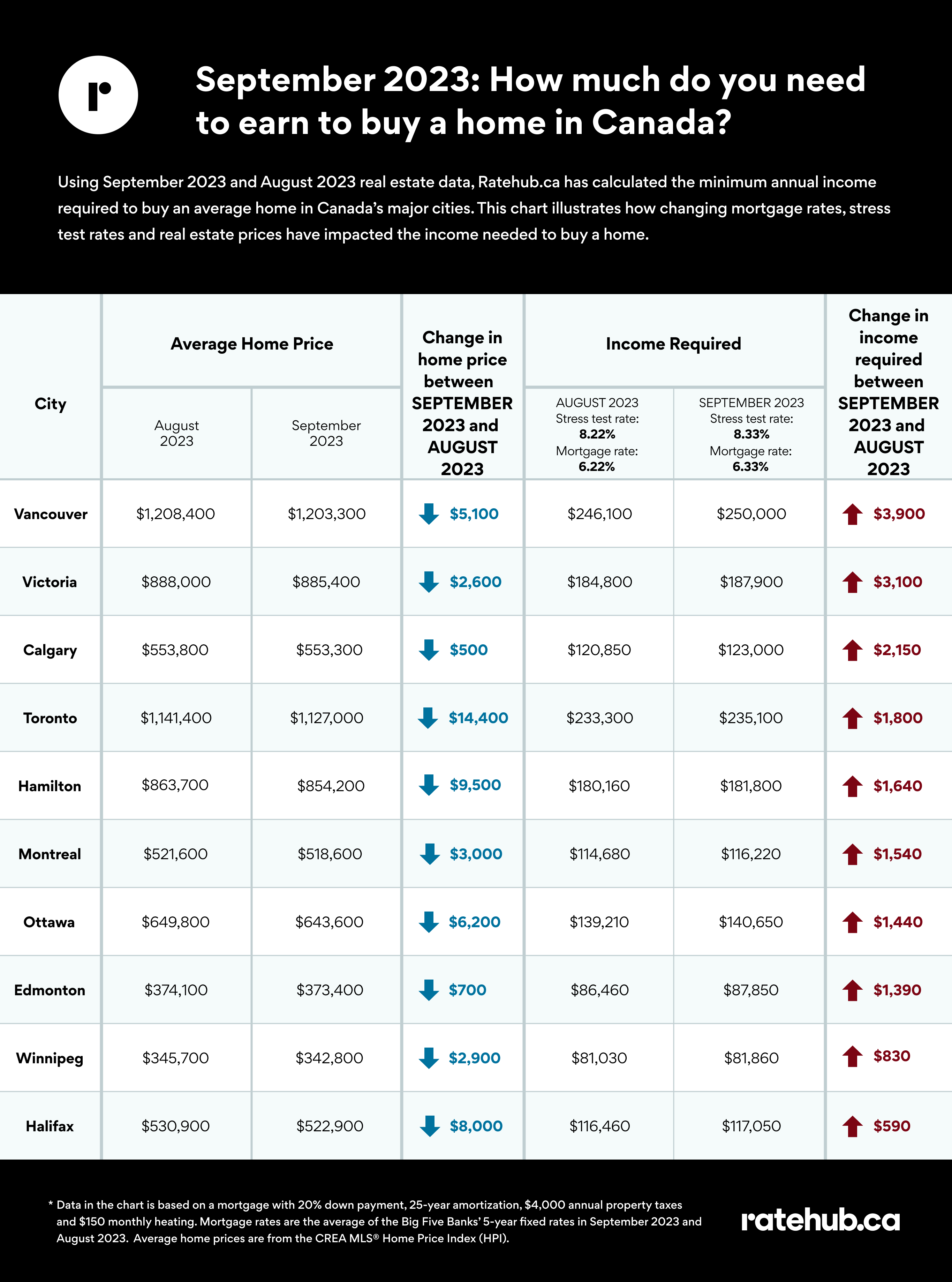Current housing system does not account for changing population trends, argues expert

Canada’s housing affordability debacle is showing little sign of easing in 2023 – and despite the market slowdown of recent times, the income required to purchase a home across major cities remains eye-wateringly high.
According to Ratehub.ca, which releases monthly updates on the minimum income needed to buy an average property in different markets, affordability declined across 10 prominent urban areas between August and September of this year.
Vancouver and Toronto unsurprisingly top the list in terms of income required to purchase. In Vancouver, buyers need an average yearly income of $250,000 – up $3,900 over the previous month despite home prices falling during the same period – while in Toronto, that figure stands at $235,100.
That’s based on a September stress test rate of 8.33% and mortgage rate of 6.33%, with six of the eight other cities on the list requiring income of well over $100,000 to purchase an average property.
Only Edmonton and Winnipeg – at $87,850 and $81,860 respectively – were affordable enough for Canadians earning a salary under six figures, Ratehub said.

Outlook worsening for single buyers in particular
All that adds up to a daunting affordability outlook for prospective homebuyers, particularly single Canadians hoping to purchase a property – and the current housing system is outdated and weighted unfairly against the growing number of would-be buyers relying on a sole income, according to a prominent observer.
JP Boutros (pictured top), a leading government relations adviser in the mortgage industry, told Canadian Mortgage Professional that single or unpartnered Canadians faced an enormous challenge qualifying for a mortgage under current arrangements.
“It’s that much harder because the way the system has been designed for the baby boomer is [with] the assumption that there are two incomes in a household or there are two people in a household,” he said, “and that just doesn’t bode well for the realities of newer generations, post-millennials.
“Those Zoomers who might just prefer to be alone or might just be forced to live alone – they have to come up with a scratch in a world that seems to think that two people live together. And that is just patently wrong for now.”
Canada’s single population has risen precipitously in recent decades, according to Statista. In 2000, the country had 7.63 million single men and 6.74 million single women, figures that had jumped to 9.67 million and 8.6 million by 2022.
A significant shift in government policy towards the housing market is required to reflect that changing landscape, Boutros said, one which has yet to materialize.
“The way that the markets are designed, the way the ability to borrow money is designed, the way to just come up with the rents is designed, just makes it that much harder,” he said. “And every little bit of policymaking that does that is something that needs to be discussed more with government and with elected officials.
“The development charges, the timelines of zoning changes, everything is just not able to accelerate enough to take into account what has been known for the last three years, which is that people are living differently and people are not allowed to live that way because of [how] everything is structured.”
Renters spent more money on housing compared to homeowners as they spent an average 43% of their pre-tax income, according to a new survey by ratefilter.
— Canadian Mortgage Professional Magazine (@CMPmagazine) October 23, 2023
Read more: https://t.co/W2EoaRhlpa#MortgageIndustry #HousingMarket #InterestRates #Mortgage
Grave consequences possible if government fails to tackle crisis
At last week’s Mortgage Professionals Canada (MPC) conference in Toronto, CIBC deputy chief economist Benjamin Tal argued that the repercussions of not solving the current housing affordability crisis could be seismic.
“We are in a major affordability issue that eventually will lead to rental strikes, civil unrest, and anti-immigrant sentiments,” Tal said.
The veteran economist argued that the crisis is more severe than widely realized because the government is undercounting the number of non-permanent residents in Canada by potentially hundreds of thousands.
That’s because Statistics Canada assumes the minute a student’s temporary visa expires, that individual leaves the country – but a huge percentage are staying in Canada legally on implied status and by other means. “If you think that the demand-supply mismatch is bad, it’s worse than you think. Much worse,” Tal said.
The presence of elected representatives and policymakers who understand the generational shift at play in Canadian society, Boutros said, is essential to making sure it is addressed in the future.
“Having younger people in the levers of power is very important to give a perspective that perhaps isn’t necessarily known by older members of parliament, Senators and people who are in senior reaches of institutions like the Bank of Canada and OSFI [Office of the Superintendent of Financial Institutions],” he said.
“It cannot be myopic. It has to reflect reality. And that’s a wholesale [shift] that needs to be done through political changes.”
Make sure to get all the latest news to your inbox on Canada’s mortgage and housing markets by signing up for our free daily newsletter here.



